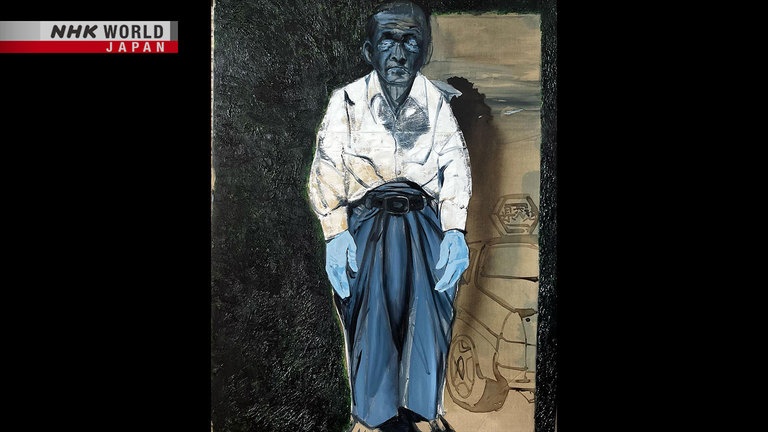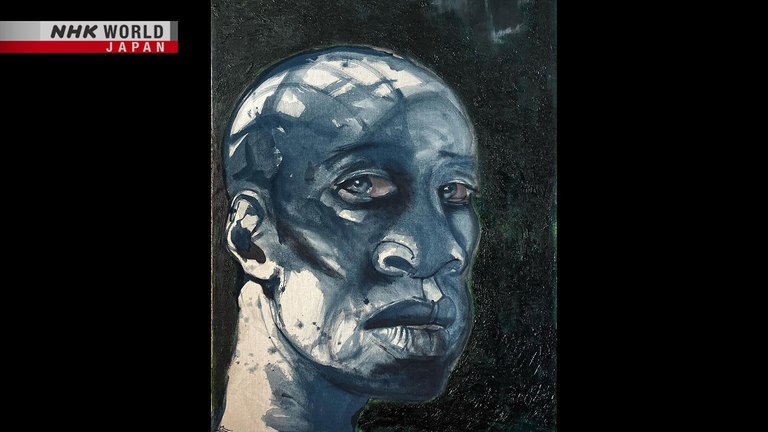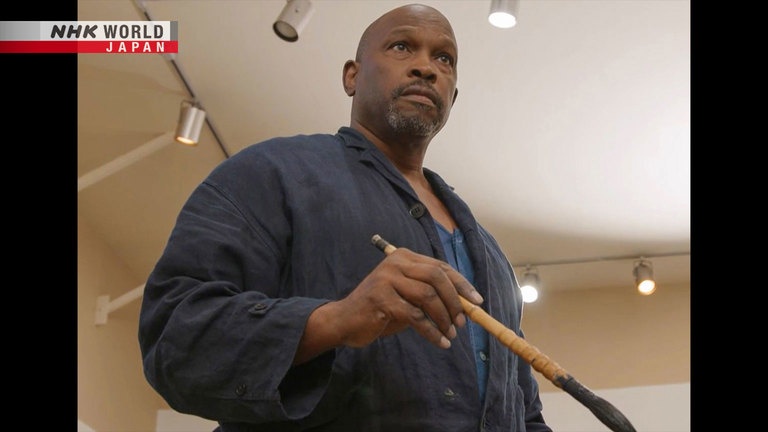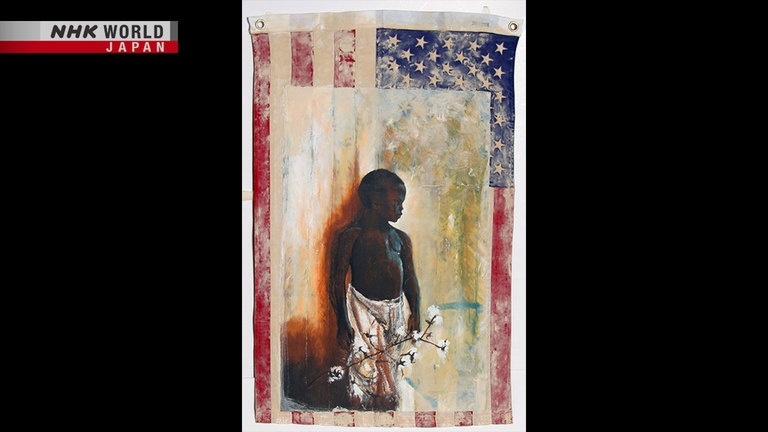Art Beyond Cultural Barrier: Chaz Guest / Artist
Prominent American artist Chaz Guest is embarking on a new challenge. He is focusing on Ai, indigo blue, used in indigo dyeing in Japan. The program conveys a message poured into his work.




Transcript
Direct Talk
His distinctive style of painting has often
been described as "profound inventiveness"
and has been attracting
considerable attention in the art world.
Meet the American painter Chaz Guest.
He has painted countless portraits
of anonymous people.
And his unique style of painting
that seemingly brings out the depths of the
subjects' hearts has been highly acclaimed.
I think my way of living is
to explore more how great it is
just to be a human being in general.
So I revel in different cultures,
I love culture.
But I am one not to live inside of one box.
I live in the box of humanity.
U.S. President Barack Obama had painting
of Chaz's hanging in the Oval Office.
And popular TV show host Oprah Winfrey,
and famous actresses such as
Angelina Jolie are his avowed fans.
In 2023, he began working
on the creation of a new series.
He began to use the traditional Japanese dye
used in aizome, or indigo dyeing,
to produce his paintings.
He claims to have been strongly
attracted to its delicate blue color.
Chaz Guest has always effortlessly transcended
cultural barriers in the world of art.
What kind of thoughts are
put into his works of art?
Let's take a look
at his message to the world.
Art Beyond Cultural Barrier
Chaz Guest continues
his creative work in Los Angeles.
The creative inspiration for Chaz,
who became a painter after working
as an illustrator for fashion magazines,
was his feelings for his
African-American ancestors,
who were survivors in the American society.
I love my own culture.
As an African-American and where we are
from and all of that, what we endured
and what and how we came to be even today.
So I come from a line of people
who were always interested in doing
pulling ourselves up by our bootstraps
and making the best out of everything.
And my grandfather, too,
and mother and father.
So I come from a very strong line
of great, strong people.
I love exploring cultures, right.
But it felt like I couldn't really get into
telling somebody else's culture
without first really diving into mine
fully, you know?
for anything to start,
you got to go to the root.
And so the root here in America
was slavery and the cotton fields.
And so I wanted to bring about
these are in the visuals that I painted.
I wanted to the get into their soul
and then depict them on the canvas.
Chaz began painting
the images of his ancestors
who worked as slaves
in the cotton fields of America.
He thought about the life of
each individual that he depicted.
And, you know, it was really interesting,
all of my friends, because
I have friends from all walks of life,
when they looked at these paintings,
they said that
it reminded them of their mother
or their grandmother or their grandfather.
They could be Asian or European or whoever.
And I was like,
that was the indication for me
that I have painted humanity.
I have exceeded the color
that you see on the canvas,
and I've actually painted humanity by that.
Chaz Guest is now also involved in
creative activities in Japan.
When he was a teenager, he started karate,
and became interested in
Japanese bushido and traditional culture.
Then, in 2023, he had an encounter
that would change everything.
It was during a visit to an indigo-dyeing
workplace in Tokushima Prefecture.
The group that he visited
was working to introduce
the wonders of traditional indigo farming
and dyeing to the world.
The delicate blue color of the
fabric products he encountered there
was unlike anything he had ever seen before.
That color is very interesting
I'm always seeking to, like,
do other things, like explore other mediums,
investigate other things.
And especially when it comes to color,
finding colors.
A few months ago,
we were invited to Tokushima by a friend.
And to my great surprise,
when we went on this farm,
this indigo farm, BUAISOU,
it just like, completely
captivated my imagination
with how they came about coming to this color
from the ground, from the seeds,
from the harvest,
from the drying of the leaves, the mixture,
the whole concoction
is just absolutely fascinating.
Chaz found out firsthand
that the indigo dye-making process
is an unimaginably long one.
I saw them make that beautiful blue dye
from the dirt
and seeds.
I saw the seeds.
I saw them planting for the next season
from that dirt,
these green, beautiful flowers.
And then they harvest them.
They even have to keep
the bugs off of the leaves.
That's so much work.
It's too much work.
And if you see a piece of indigo clothing
that you like, just buy it.
Don't worry about the price they work for it.
Trust me, nobody is going to do it.
They have the leaves and then
they dry them out and then
they still air them out and then
they would have got ferment them.
Then they start putting the
the water, alkaline water,
the brand, you know, like oat
because it's alive.
You can only dye
a couple of pieces at a time,
because it's breathing.
Even when I dyed some stuff,
it was on my fingers for a month.
And I was just like, I got to see
how I can paint with this stuff.
Chaz began working with
two types of dyes for his artworks.
One was the extract from
a fresh Tade-Ai leaf, indigo plant.
With this, he would paint
a delicate blue color.
The other was a traditional indigo dye.
When painted on canvas, it appears brown.
He combined it with the blue color to create
changes in expression of the people he drew.
Chaz showed us
one of his completed portraits.
This piece depicts a taxicab driver.
By using a variety of subtle blue colors,
he was able to express
the driver's most inner feelings.
I brought about this subject
of the taxi driver
who...
I just felt I felt him
very interesting as a character.
This was in Tokushima.
and this was his job and
this was his life he took pride in.
And this one thing that he does for his life.
This is one of the craftsmen
at the indigo dyeing studio.
He is depicted as a powerful figure,
silently continuing his work.
Chaz and Japan.
These works are the result
of the fusion of two cultures.
What he considered most important
in the creation of his works
was what he called the "commonality"
as human beings.
I'm the kind of guy that would always
love to bring our likenesses together
instead of our differences.
So basically, we're all the same. Right.
If you stripped off our skin,
we're like this skeletal thing
with a brain with two big eyeballs,
like golf ball eyeballs,
brain spinal column with nervous system,
you look like an alien, right.
And then you put, like, this meat suit on,
and then you look slap a color on.
You might like do something,
this is the same stuff
and this sort of like
what, you think you're better than me.
I just don't get it.
I just think with my brain,
the brain that I've been given
and its function,
it's like the things that you miss out
on with that nonsense.
And so I've always had
the kind of imagination that would,
what if we didn't have that?
If we weren't privy to that and
we just moved along as human beings,
how amazing that would be.
"The power of art can transcend
cultural and racial barriers."
And it was this strong conviction of Chaz's
that opened the door to a new project.
It was the "World Art Project."
Since visiting the West African
country of Gambia in 2010,
Chaz has been interacting with children
from all over the world through art.
Through his activities,
he had something that he wanted to convey
to children living in poverty and conflict.
I think it's easier to be
evil
and less than
I think it's harder to
walk the road of righteousness
or divinity.
If you can imagine
the spirit of good.
That's what my mother
used to always tell me.
And now it's matured in my body.
My mother used to say,
we are under the spirits
of two powers.
It's good and evil.
She always said that.
But the older I get,
the more I can not only see it,
but it's just true.
And again, we come from a people
that had to rely on hope.
So if you ask me that, I'm going to say
you just keep trying to do your best.
If you're blessed to wake up,
you just go for the good
and then you will be free from slavery.
Chaz's dream for the future
is to create a place
where children from all over the world
who participated in the project
can interact with one another through art.
I love children. I love to see
their pure approach to things.
And if I'm in Mexico, if I'm in the Gambia,
West Africa or Senegal or
or even Japan, I have gathered some children.
Well, where else?
Oh, in in France. You know.
I think that one day it'll all come together
as the World Art Project.
On this day, Chaz completed a painting of a
jazz band, which he painted with indigo dye.
One can only wonder what will be created
next by his brimming imagination.
"Thank you very much."
We will have to keep a watchful eye
on his activities.
At the end of the interview,
Chaz Guest shared with us
some of his most important words.
"Life is an art form."
"Learn how to live."
Because life is so beautiful
as beautiful as art.
And if you want to
have this life as an art form,
one must learn how to live.
Put that in your pipe and smoke it.